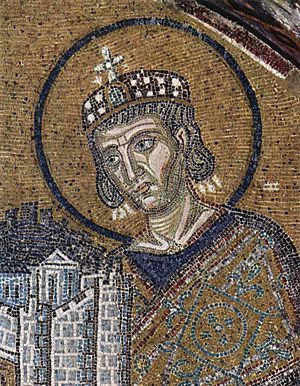First Council of Nicaea facts for kids
The First Council of Nicaea was a very important meeting held in the city of Nicaea (which is now called İznik in Turkey) way back in the year 325. The Roman Emperor Constantine I called together many leaders of the early Christian Church. This meeting was the first "ecumenical council," meaning it was meant for the whole Christian world. Its most important outcome was the creation of the first official Christian doctrine, known as the Nicene Creed.
This council set a pattern for future big meetings of bishops (called Synods). These meetings would create statements of belief and church rules to help keep Christian beliefs united across the entire Christian world.

Contents
What They Talked About
The main topics discussed at this important meeting were:
- A big disagreement about Jesus's nature.
- When to celebrate Easter.
- A split in the church called the Meletian schism.
- Whether the Father and Son were one in purpose or truly one in being.
- How to handle baptism for people who had left the church.
- What to do with Christians who had given up their faith during hard times.
Key Decisions Made
The main goal of the council was to solve arguments within the Church of Alexandria about Jesus's relationship with God the Father. People wondered if Jesus was made of the exact same "substance" as God the Father, or just a similar one.
St. Alexander of Alexandria and Athanasius believed Jesus was of the same substance as the Father. But a popular priest named Arius (from whom the term Arian controversy comes) believed Jesus was only of similar substance. The council voted against Arius's ideas. Almost all the bishops (around 250-318 of them) voted against him.
Another important decision was agreeing on the date for Christian Passover (which we now call Easter). This is the most important celebration in the Christian calendar. The council decided that Easter should be celebrated on the first Sunday after the first full moon following the spring equinox. This meant it would be celebrated independently of the Bible's Hebrew calendar. The Bishop of Alexandria was given the job of announcing the exact date to other bishops each year.
The Council of Nicaea was very important in history. It was the first time the church tried to reach a common agreement by bringing together representatives from all over Christendom. It was also the first time they really focused on defining who Jesus was in a detailed way. Emperor Constantine calling and leading the council also showed that the emperor had some control over the church.
By creating the Nicene Creed, the council set a rule for future big meetings. These meetings would create statements of belief and church rules (called canons). These rules were meant to guide what Christians believed and to keep the whole Christian world united. This was a huge moment for the history of the Church and for Europe.
Why the Council Was Called
Emperor Constantine I called the First Council of Nicaea after getting advice from a group of church leaders led by Hosius of Cordoba in the spring of 325. Many bishops believed that Arius's teachings were wrong and dangerous for people's souls.
In the summer of 325, bishops from all over the Roman Empire came to Nicaea (in modern-day Turkey). It was a good location for most of them to reach, especially those from Asia Minor, Syria, Palestine, Egypt, Greece, and Thrace.
About 300 bishops attended. They came from almost every part of the Empire, except Britain. This was the first major council for the whole Church since the early Council of Jerusalem mentioned in the Bible. At the Council of Nicaea, the Church took a big step to clearly define its beliefs because of the challenge from Arius's ideas. The decisions made at this council were meant for the entire Christian Church.
Who Attended
Constantine had invited all 1800 bishops of the Christian church (about 1000 in the east and 800 in the west). However, only about 250 to 320 bishops actually came. Some historians like Eusebius of Caesarea counted 250, while Athanasius of Alexandria counted 318.
The bishops were given free travel to the council and free places to stay. They didn't travel alone; each bishop could bring two priests and three deacons. So, the total number of people attending was probably over 1500.
This council was also special because it happened right after the end of the persecution of Christians. This persecution had officially ended in February 313 with the Edict of Milan by Emperors Constantine and Licinius.
Most of the bishops who attended were from the Eastern parts of the Roman Empire. The most important among them were the three patriarchs: Alexander of Alexandria, Eustathius of Antioch, and Macarius of Jerusalem.
From the Latin-speaking Western provinces, at least five representatives came. Pope Silvester I did not attend because he was ill, but he sent two priests to represent him.
Athanasius of Alexandria, who was a young deacon at the time, came with Bishop Alexander of Alexandria. Athanasius later spent most of his life fighting against Arianism.
Images for kids
-
Icon showing Emperor Constantine and the bishops of the First Council of Nicaea (325) holding the Niceno–Constantinopolitan Creed of 381
-
A fresco showing the First Council of Nicaea at the Vatican's Sixtine Salon
See also
 In Spanish: Concilio de Nicea I para niños
In Spanish: Concilio de Nicea I para niños


